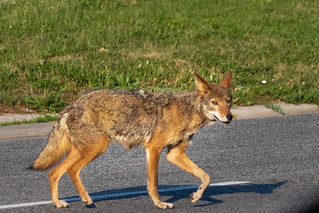Hello Neighbor

The coyote population in New York City has exploded over the past few years. (Photo/Flickr)
Hello, Neighbor
Reported By: Isabel Danzis
Adapted For Print By: Caroline Ealy
It isn’t uncommon for New Yorkers to come across small animals on their daily commute – birds, squirrels and the common city-dwelling rat, to name a few. However, New York City has seen an unexpected influx of a bigger animal. There have been frequent coyote sightings over the past few years. Coyotes now call many cities across the United States home.
Researcher Carol Henger works for the organization Gotham Coyotes, which tracks coyote populations and their movements throughout the five boroughs. Henger says that coyotes moved from the Midwest to New York state in the 1940s, eventually making their way to the Bronx in the ‘90s. Recently, they’ve begun expanding their territory outside of the five boroughs and into Long Island.
New York serves as a great location to study coyotes because it's one of the last urban communities to welcome the population. The city provides a perfect home for the newly flourishing coyote populations because they only need two basic things to live. “It seems like coyotes are able to live anywhere where there’s enough green space to be able to hide so they’re not seen by humans and enough food, and that’s really all they need,” Henger said. “They’re a special case, not all animals can do this. But a lot of urban research has shown that in order to thrive in urban areas, you do really need this behavioral plasticity.”
Henger points to the abundance of greenspace in the City, which makes for lush habitats. Humans discard extra food scraps, which leaves the urban scavengers well-fed. The metropolitan landscape even mirrors the wild in some ways. Coyotes have access to everything they normally eat – birds, insects, rabbits and even larger mammals like deer. They also supplement their natural diet with human food like chicken, beef and pork, something they can find in every trash bag on every New York City corner.
However, the key to coyotes survival in New York City is rooted in the behavior of plasticity that Henger highlights. “Urban areas, they’re not static,” Henger explained. “So, you really do have to be able to change your behavior to fit the situation and coyotes are pretty much the number one example of that.”
As part of her research, Henger made a family tree in hopes of mapping out coyotes’ bloodlines to better track the generations living in our area. Henger found that in larger green areas – like Pelham Bay Park – there is evidence that generations of coyotes inhabit that area, suggesting that they are not only surviving, but also thriving. “It gave us the idea that they were staying here over a couple of generations, the same coyotes,” said Henger. “It wasn’t just a sample of coyotes coming to the city and not surviving.”
According to Henger, coyote populations are still expanding throughout the five boroughs, which only adds to the genetic diversity of the existing populations. Both Henger’s family tree and tracking data provided researchers with a comprehensive understanding of the migration of coyotes and how they are adapting to city life. Truly reinforcing the idea that coyotes and people aren't that different, both populations turn to New York to provide them with what they need to thrive. --

